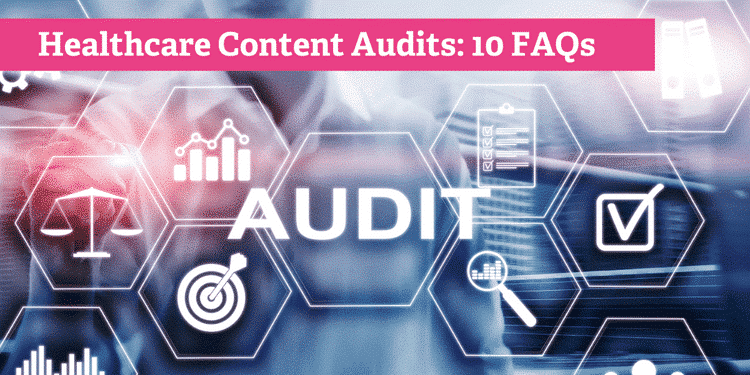
We get it. “Audit” is a dirty word to marketers. It feels a lot like cleaning out the attic — vulnerable, nostalgic and grueling.
You’ll probably find boxes you haven’t touched in years (with clothing that’s so old, it’s back in style — hello, low-rise jeans). You’ll discover items you wish you hadn’t kept. (Did you really need to hang on to all 6 of your daughter’s notebooks from 8th grade?)
But it’s worth it. When it’s over, you’ll feel relieved and reenergized.
The same can be said about performing a content audit.
Do you have a content audit coming up? We’re here to help. Read 10 frequently asked questions about content audits in healthcare marketing.
Note: The answers below are general in nature. Reach out for recommendations specific to your health system or to learn how Aha Media Group performs multichannel healthcare content audits.
Why Healthcare Content Audits Are Important
1. What are the main goals of a content audit?
There are several reasons why health systems perform audits, depending on the specific organization. In general, audits pave the path to achieving 3 main goals:
- Understanding the content you have
- Assessing its performance
- Determining how to improve your content to better align with business goals
2. What are the benefits of auditing your content?
Comprehensive audits are worth the effort. Auditing your healthcare content can help you:
- Improve patient engagement and acquisition: Audits open your eyes to channels and webpages that could be more engaging, patient-centric and easy to understand or navigate.
- Enhance healthcare brand visibility: A healthcare website content audit reveals how your website can be more competitive, increase rankings and boost traffic. A social media audit uncovers ways to improve engagement and visibility.
- Find opportunities to compete: A competitor analysis serves as a roadmap to find and capitalize on shortcomings. It isn’t surprising to find gaps you can fill in — whether those gaps exist in local SEO, email, service line pages or other channels.
- Demonstrate the ROI of marketing efforts: Find quick wins and opportunities to differentiate your brand in the competitive healthcare market (and impress leadership).
- Keep up with hospital content management: Once you assess your content ecosystem and update or sunset the pages you may have forgotten about, set a plan to regularly update your content.
Looking for proof of how a content audit can benefit a health system? We audited Advocate Aurora Health’s content and created a healthcare content strategy that increased:
- User engagement by 20%
- Video plays by 25%
- Pages per session by 22%
- Find-a-doctor action by 17%
3. What might we uncover during an audit?
There’s no reason to fear what an audit could uncover. Most of the time, people actually feel validated by the findings. Your instincts are likely correct — and the audit can often provide evidence to back up the changes you want to make.
But you may be surprised by the sheer volume of content, especially on your website. Blogs, in particular, have a knack for becoming outdated and flying under the radar.
How to Plan a Comprehensive Content Audit
4. How long can the process take?
A multichannel audit can take a few weeks or several months, depending on how many channels and how much content your health system has.
The team performing your audit also plays a factor. If your team is busy with the day-to-day, partnering with professional content audit service providers can keep your audit running on schedule regardless of what comes up on your end.
5. What if we have limited time and resources?
Prioritization is the name of the game. Rome wasn’t built in a day. Neither was Mayo Clinic’s content strategy — or any other health system’s, for that matter.
It could make sense for you to prioritize:
- What’s important to leadership: Which areas do executives and stakeholders keep bringing up? Start there to secure buy-in.
- The most pressing problems: Handle the big issues first. Which content do you know is negatively impacting your health system?
- The quick wins: Every content ecosystem has low-hanging fruit. Find your pathways to quick results and keep your leadership updated.
- One channel at a time: Start with your website, then move on to social media and work at a pace you can keep up with.
6. Who should conduct the audit?
Your organization’s content owner should head up the healthcare content audit. They know the strategy, objectives and shortcomings intimately.
But make sure you also include team members who aren’t quite as connected to the content. The curse of being the content owner is that it’s hard to “kill your darlings” — those old, outdated pieces you once poured your heart into.
If you work with an outside partner for your audit, choose a content agency that knows healthcare and has myriad case studies showing their results (and references singing their praises).
Searching for a partner who can help with your audit? Let’s talk.
7. When is the best time to perform an audit?
An audit gives you the information you need to plan and create effective content. If you’re changing your strategy or preparing for a hospital website redesign, first look at the data to understand how your content is performing and why.
Once you know what you’re working with, you can plan what to update, remove or create.
How to Perform a Healthcare Content Audit
8. What’s included in a comprehensive healthcare content audit?
An easier question would be what isn’t included in a content audit.
Multichannel content audits for health systems assess:
- SEO performance: Use website analytics tools to assess the metrics that matter (like traffic and conversion) and find SEO issues like missing or duplicate metadata.
- Content quality: Potential issues include thin or outdated content, misalignment with business objectives, missing calls to action and inconsistent voice. Learn about other common hospital website content mistakes.
- Website usability: Is your site structure intuitive? Are you following accessibility standards? Comprehensive audits factor in usability best practices.
- Social media marketing: Assess your social media channels. It may be time to change your strategy or sunset unused sub-accounts.
- Competitive gap analysis: Determine what competitors are doing well and where you have the advantage (or can create one). Inspect areas like website navigation, content quality and SEO competencies.
9. Where should we start when looking for outdated or underperforming content?
Identifying outdated healthcare content is relatively easy. Think about what’s changed in your organization (or the world) since you last performed an audit. Begin with those pieces of content. For example:
- Does your website list physicians or stakeholders who no longer work with your health system?
- Check your COVID-19 content. Does it say masks are required? Is that still true?
- What vocabulary surrounding your service lines has changed since your last audit?
- Don’t forget about images and videos. Do they look outdated? (Pro tip: Using medical animations can make your content more evergreen.)
Assessing content performance is more challenging. Factor in both qualitative criteria (like relevance, readability and adherence to E-E-A-T) and quantitative metrics (like website analytics and social engagement).
What to Do After the Audit
10. What steps should we take after the audit?
After your content audit is complete:
- Document and share the results: Socialize the findings with a short but impactful brief. Focus on opportunities and action items rather than simply listing the stats so that leadership can quickly see why the findings matter.
- Create your content improvement strategy: Give everyone time to process the results. Then, collaborate for a brainstorming session. Accept stakeholder feedback and incorporate their suggestions in your next steps.
- Begin content improvements: Remember to prioritize action items and keep stakeholders updated with progress reports showing the impact of your audit
- Plan the next audit: Thought you were finished? The healthcare content improvement process never really ends — it goes in cycles. Depending on your publishing cadence, schedule annual or quarterly audits moving forward. The more often you audit, the easier (and faster) each audit will be.
Sourcing Support for Your Healthcare Content Audit?
We’ve helped over 180 health systems create content that speaks to patients. Learn about our experience performing healthcare content audits and building content strategies that convert.




